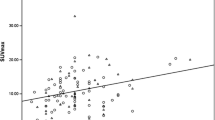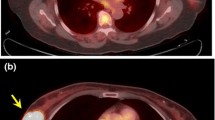Abstract
Purpose
We investigated whether maximum standardized uptake value (SUVmax), metabolic tumour volume (MTV), total lesion glycolysis (TLG) and whole-body (WB) SUVmax, WB MTV and WB TLG measured by 18F-FDG PET/CT could improve prognostic stratification in patients with stage II/III breast cancer (BC).
Methods
We prospectively enrolled 99 consecutive women (median age 50 years, range 27 – 77 years) with pathologically proven stage II/III BC who underwent pretreatment FDG PET/CT. WB SUVmax, WB MTV and WB TLG were measured in all malignant lesions. Survival was analysed using the Kaplan-Meier method. Cox proportional hazards models were constructed to test for relationships among WB SUVmax, WB MTV, WB TLG, and overall survival (OS) and disease-free survival (DFS), after adjustment for age, and histopathological and immunohistochemical features (oestrogen/progesterone and HER2 expression, proliferation index and grade).
Results
The median values of WB SUVmax, WB MTV and WB TLG were 16.2 (range 1.5 – 33.1), 14 cm3 (range 0.03 – 708.6 cm3) and 62.5 (0.06 – 3869.4), respectively. All WB semiquantitative values were higher in patients with higher TNM stage, although not significantly (all p > 0.05). The median follow-up for surviving patients was 30 months, with a range of 13 – 45 months. Both PFS and OS of patients with low WB SUVmax, WB MTV and WB TLG were longer than that of patients with high WB values for progression, although not statistically significant. However, stratifying the patients in accordance with the stage of disease, both PFS and OS were significantly lower in patients with high WB TLG and stage III than in patients with stage II (p < 0.05). In multivariate analyses, WB MTV and WB TLG were independent prognostic factors for PFS (hazard ratio 1.004, 95 % confidence interval 1.002 – 1.006, p < 0.001, and hazard ratio 1.001, 95 % confidence interval 1.000 – 1.001, p = 0.011, respectively).
Conclusion
The addition of WB TLG to clinical data may provide a more detailed prediction of outcome in patients with stage III BC. Moreover, WB MTV and WB TLG are independent factors predicting recurrence of BC. On the contrary, WB SUVmax has poor prognostic significance in this cohort of patients.

Similar content being viewed by others

References
Goldhirsch A, Winer EP, Coates AS, Gelber RD, Piccart-Gebhart M, Thurlimann B, et al. Personalizing the treatment of women with early breast cancer: highlights of the St Gallen International Expert Consensus on the Primary Therapy of Early Breast Cancer 2013. Ann Oncol. 2013;24:2206–23.
Raica M, Cimpean AM, Ceausu RA, Fulga V, Nica C, Rudico L, et al. Hormone receptors and HER2 expression in primary breast carcinoma and corresponding lymph node metastasis: do we need both? Anticancer Res. 2014;34:1435–40.
Ozkan E. Positron emission tomography/computed tomography in locally advanced breast cancer. Exp Oncol. 2013;35:253–7.
Baba S, Isoda T, Maruoka Y, Kitamura Y, Sasaki M, Yoshida T, et al. Diagnostic and prognostic value of pre-treatment SUV in 18F-FDG/PET in breast cancer: comparison with apparent diffusion coefficient from diffusion-weighted MR imaging. J Nucl Med. 2014;55:736–42.
Kadoya T, Aogi K, Kiyoto S, Masumoto N, Sugawara Y, Okada M. Role of maximum standardized uptake value in fluorodeoxyglucose positron emission tomography/computed tomography predicts malignancy grade and prognosis of operable breast cancer: a multi-institute study. Breast Cancer Res Treat. 2013;141:269–75.
Kim J, Yoo W, Kang S-R, Cho SG, Oh JR, Chong A, et al. Prognostic significance of metabolic tumor volume measured by 18F-FDG PET/CT in operable primary breast cancer. Nucl Med Mol Imaging. 2012;46:278–85.
Satoh Y, Nambu A, Ichikawa T, Onishi H. Whole-body total lesion glycolysis measured on fluorodeoxyglucose positron emission tomography/computed tomography as a prognostic variable in metastatic breast cancer. BMC Cancer. 2014;14:525–36.
Sataloff DM, Mason BA, Perestipino AJ, Seinige UL, Lieber CP, Baloch Z. Pathologic response to induction chemotherapy in locally advanced carcinoma of the breast: a determinant of outcome. J Am Coll Surg. 1995;180:297–306.
Gradishar WJ, Anderson BO, Blair SL, Burstein HJ, Cyr A, Elias AD, et al. National comprehensive cancer network breast cancer panel. Breast cancer version 3.2014. J Natl Compr Canc Netw. 2014;12:542–90.
Yalcin B. Overview on locally advanced breast cancer: defining, epidemiology, and overview on neoadjuvant therapy. Exp Oncol. 2013;35:250–2.
Groheux D, Giacchetti S, Espiè M, Verecellino L, Hamy AS, Delord M, et al. The yield of 18F-FDG PET/CT in patients with clinical stage IIA, IIB, IIIA breast cancer: a prospective study. J Nucl Med. 2011;52:1526–34.
Satoh Y, Ohnishi H, Nambu A, Araki T. Volume-based parameters measured by using FDG PET/CT in patients with stage I NSCLC treated by stereotactic body radiation therapy. Radiology. 2014;270:275–81.
Zhang J, Jia Z, Zhou M, Ragaz J, Zhang YP, Wang BY, et al. The SUVmax of (18)F-FDG correlates with molecular subtype and survival of previously untreated metastatic breast cancer. Clin Nucl Med. 2013;38:256–62.
Burdic MJ, Stephans KL, Reddy CA, Djemil T, Srinivas SM, et al. Maximum standardized uptake value from staging FDG-PET/CT does not predict treatment outcome of early-stage non-small lung cancer treated with stereotactic body radiotherapy. Int J Radiat Oncol Biol Phys. 2010;78:1033–9.
Groheux D, Hatt M, Hindiè E, Giacchetti S, de Cremoux P, Lehmann-Che J, et al. Estrogen receptor-positive/human epidermal growth factor receptor 2-negative breast tumors: early prediction of chemosensitivity with (18)F-fluorodeoxyglucose positron emission tomography/computed tomography during neoadjuvant chemotherapy. Cancer. 2013;119:1960–8.
Hyun SH, Choi JY, Shim YM, Kim K, Lee SJ, Cho YS, et al. Prognostic value of metabolic tumor volume measured by 18F-fluorodeoxyglucose positron emission tomography in patients with esophageal carcinoma. Ann Surg Oncol. 2010;17:115–22.
La TH, Filion EJ, Turnbull BB, Chu JN, Lee P, Nguyen K, et al. Metabolic tumor volume predicts for recurrence and death in head-and-neck cancer. Int J Radiat Oncol Biol Phys. 2009;74:1335–41.
Lee HY, Hyun SH, Lee KS, Kim BT, Kim J, Shim YM, et al. Volume based parameter of (18)F-FDG PET/CT in malignant pleural mesothelioma: prediction of therapeutic response and prognostic implications. Ann Surg Oncol. 2010;17:2787–94.
Kim BS, Kim IJ, Kim S, Nam HY, Pak KJ, Kim K, et al. The prognostic value of the metabolic tumor volume in FIGO stage IA to IIB cervical cancer for tumor recurrence: measured by F-18 FDG PET/CT. Nucl Med Mol Imaging. 2011;45:36–42.
Kim CY, Jeong S, Chong GO, Son SH, Jung JH, Kim DH, et al. Quantitative metabolic parameters measured on F-18 FDG PET/CT predict survival after relapse in patients with relapsed epithelial ovarian cancer. Gynecol Oncol. 2015;136:498–504.
Liao S, Lan X, Cao G, Yuan H, Zhang Y. Prognostic predictive value of total lesion glycolysis from 18F-FDG PET/CT in post-surgical patients with epithelial ovarian cancer. Clin Nucl Med. 2013;38:715–20.
Kim CY, Hong CM, Kim DH, Son SH, Jeong SY, Lee SW, et al. Prognostic value of whole-body metabolic tumour volume and total lesion glycolysis measured on 18F-FDG PET/CT in patients with extranodal NK/T-cell lymphoma. Eur J Nucl Med Mol Imaging. 2013;40:1321–9.
Chen HH, Chiu NT, Su WC, Guo HR, Lee BF. Prognostic value of whole-body total lesion glycolysis at pretreatment FDG PET/CT in non-small cell lung cancer. Radiology. 2012;264:559–66.
Kim K, Kim SJ, Kim IJ, Kim YS, Pak K, Kim H. Prognostic value of volumetric parameters measured by F-18 FDG PET/CT in surgically resected non-small-cell lung cancer. Nucl Med Commun. 2012;33:613–20.
Oh J-R, Seo J-H, Chong A, Min JJ, Song HC, Kim YC, et al. Whole-body metabolic tumour volume of 18F-FDG PET/CT improves the rediction of prognosis in small cell lung cancer. Eur J Nucl Med Mol Imaging. 2012;39:925–35.
Compliance with ethical standards
Conflicts of interest
None.
Ethical approval
The study was conducted according to the principles of the Declaration of Helsinki (2000). All procedures performed in the studies were in accordance with the ethical standards of institutional and/or national research committees.
Informed consent
Written informed consent to undergo PET/CT was obtained from all subjects included in the study.
Author information
Authors and Affiliations
Corresponding author
Rights and permissions
About this article
Cite this article
Evangelista, L., Cervino, A.R., Ghiotto, C. et al. Could semiquantitative FDG analysis add information to the prognosis in patients with stage II/III breast cancer undergoing neoadjuvant treatment?. Eur J Nucl Med Mol Imaging 42, 1648–1655 (2015). https://doi.org/10.1007/s00259-015-3088-4
Received:
Accepted:
Published:
Issue Date:
DOI: https://doi.org/10.1007/s00259-015-3088-4



